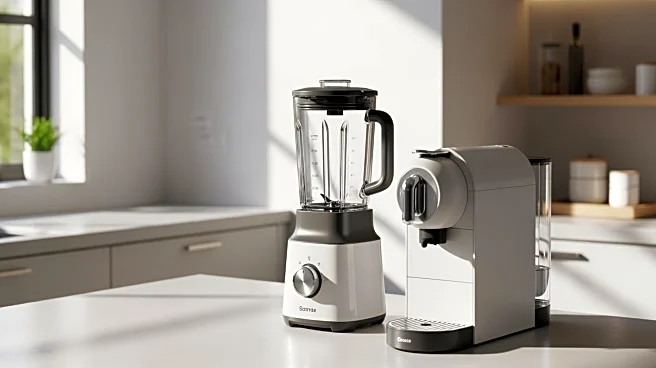What's Happening?
A range of small appliances is transforming kitchen efficiency and space management, offering smart and affordable solutions for various culinary tasks. Notable products include Vitamix blenders, Instant
Pots, Ninja multi-cookers, and De’Longhi espresso machines. These appliances provide multiple functionalities, such as blending, chopping, pressure cooking, and espresso making, all designed to save time and counter space. The Vitamix blender, for instance, features a high-performance motor and multiple speed settings for diverse culinary applications. Similarly, the Instant Pot offers seven cooking methods, including pressure cooking and yogurt making, with pre-programmed options for ease of use. Other appliances like the Dyson V9 Motorbar stick vacuum and Black + Decker convection toaster oven further enhance household efficiency with features like wireless operation and air frying capabilities.
Why It's Important?
The introduction of these small appliances is significant for U.S. households seeking to optimize kitchen space and improve cooking efficiency. As urban living spaces become more compact, the demand for multifunctional and space-saving kitchen tools is increasing. These appliances cater to the growing trend of home cooking and health-conscious eating by providing convenient and versatile options for meal preparation. Consumers benefit from reduced cooking times and enhanced culinary capabilities, potentially leading to healthier eating habits and more time for other activities. Additionally, the affordability and accessibility of these appliances make them attractive to a wide range of consumers, from busy professionals to families.
What's Next?
As the market for small appliances continues to grow, manufacturers are likely to innovate further, introducing new features and technologies to enhance user experience. Future developments may include more energy-efficient models, integration with smart home systems, and expanded functionalities to cater to diverse culinary preferences. Consumer feedback and technological advancements will drive the evolution of these products, potentially leading to even more compact and efficient designs. Retailers and manufacturers may also focus on marketing strategies that highlight the convenience and health benefits of these appliances, appealing to environmentally conscious and health-focused consumers.
Beyond the Headlines
The rise of small appliances reflects broader societal shifts towards sustainability and efficiency. As consumers become more aware of environmental impacts, the demand for energy-efficient and multifunctional appliances is likely to increase. This trend may influence the design and production practices of manufacturers, encouraging the use of sustainable materials and eco-friendly technologies. Additionally, the popularity of these appliances may spur innovation in related industries, such as smart home technology and kitchen design, further transforming the way people interact with their living spaces.











